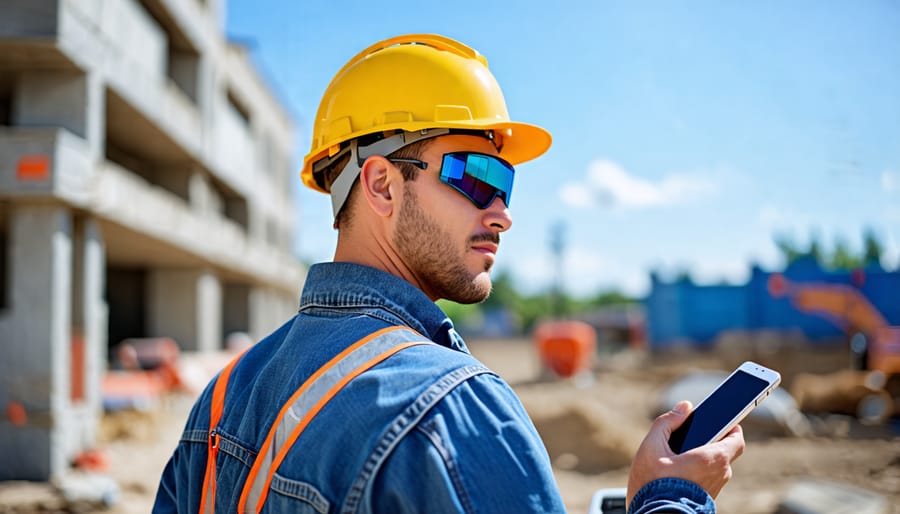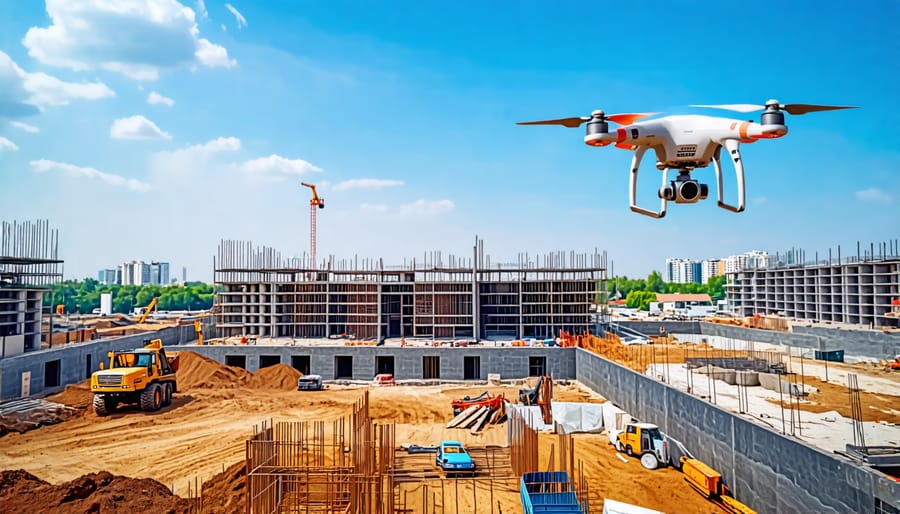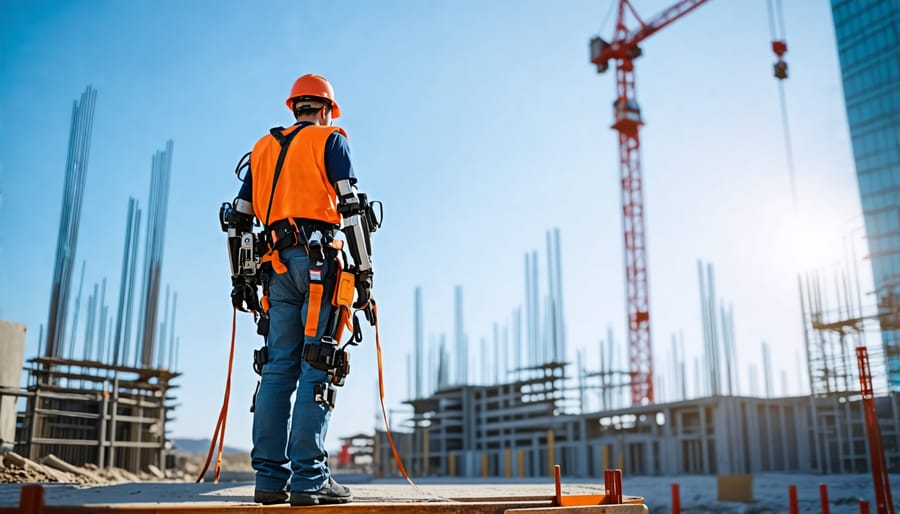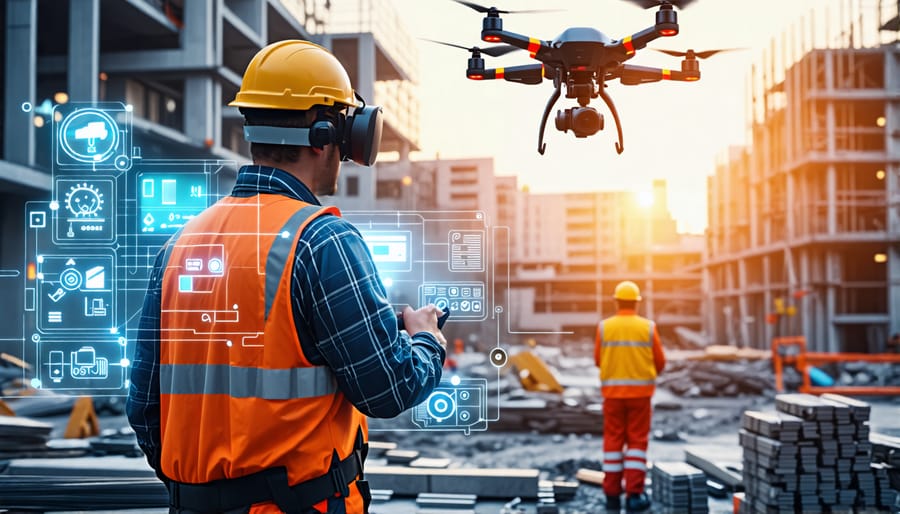Embrace the safety technology revolution transforming the industry. Prioritize worker well-being by adopting wearables that monitor vital signs, alert fatigue, and prevent accidents. Leverage drones for remote site inspections, identifying hazards without risking lives. Implement IoT sensors to continuously monitor environmental conditions, equipment performance, and worker locations, enabling proactive safety measures. The importance of safety technology cannot be overstated – it’s a powerful ally in our mission to protect the workforce driving construction forward. By harnessing cutting-edge innovations, we create safer job sites, boost productivity, and shape a future where every worker returns home unharmed. The time to invest in safety technology is now – for the well-being of our people and the success of our industry.
Wearable Safety Devices

Smart Helmets
Smart helmets are revolutionizing construction safety by integrating advanced sensors and communication capabilities. These high-tech helmets can detect potential hazards, such as falls, collisions, or dangerous environmental conditions, and alert the wearer and safety managers in real-time. Equipped with features like GPS, impact sensors, and two-way audio, smart helmets enable faster response times and improved situational awareness on the job site.
In addition to enhancing worker safety, smart helmets also offer valuable data insights for construction companies. The sensors can track worker locations, monitor fatigue levels, and provide data on safety incidents and near-misses. This information helps companies identify high-risk areas, optimize safety protocols, and make data-driven decisions to improve overall safety performance.
As the construction industry continues to prioritize worker well-being and risk management, the adoption of smart helmets is expected to grow significantly. By leveraging this innovative technology, companies can create safer work environments, reduce accidents, and ultimately save lives on construction sites.
Smart Safety Vests
Smart safety vests equipped with GPS and biometric sensors are revolutionizing worker safety and productivity on construction sites. These innovative vests track workers’ locations in real-time, enabling site managers to monitor their whereabouts and quickly respond to emergencies. Built-in biometric sensors continuously monitor vital signs such as heart rate, body temperature, and respiration, alerting supervisors to potential health issues or fatigue. By providing early warning signs, smart vests help prevent accidents and injuries, ensuring a safer work environment. Additionally, the data collected by these vests can be analyzed to optimize workflow, identify areas for improvement, and boost overall productivity. Real-world case studies have demonstrated the effectiveness of smart safety vests in reducing incident rates and enhancing worker well-being. As the construction industry continues to prioritize safety and efficiency, the adoption of smart vest technology is expected to grow, setting new standards for worker protection and project management.
Drones and Robotics

Drones for Site Surveys
Drones have revolutionized site surveys and inspections in the construction industry. Equipped with high-resolution cameras, GPS, and advanced sensors, drones can quickly and safely capture aerial data, images, and video footage of construction sites. This technology allows for efficient mapping, progress monitoring, and identification of potential hazards or quality issues. By reducing the need for workers to physically access dangerous or hard-to-reach areas, drones significantly improve safety on construction sites. They also enable more frequent and comprehensive inspections, providing valuable data for project management and decision-making. The use of drones for site surveys saves time, reduces costs, and enhances overall project efficiency while prioritizing worker safety. As drone technology continues to advance, its applications in construction will likely expand, making it an essential tool for modern construction projects.
Robotic Assistants
Robotic assistants are revolutionizing construction safety by taking on hazardous tasks and reducing human exposure to potential risks. These intelligent machines can handle activities such as demolition, heavy lifting, and working at heights with precision and efficiency. For example, remote-controlled demolition robots can safely dismantle structures while keeping workers at a safe distance. Additionally, robotic arms and exoskeletons aid in material handling and repetitive tasks, minimizing the risk of injuries from heavy lifting and strain. By deploying robotic assistants, construction companies can significantly improve worker safety, reduce accidents, and enhance overall productivity on job sites. As technology advances, the integration of robotic assistants in construction is expected to become more widespread, further enhancing safety measures and transforming the industry’s approach to risk management.
Virtual and Augmented Reality
Virtual and augmented reality technologies are revolutionizing safety training in the construction industry. These immersive technologies allow workers to experience realistic job site scenarios and practice safety procedures in a controlled environment. VR simulations can recreate hazardous situations, such as working at heights or operating heavy machinery, enabling workers to develop critical safety skills without the risk of real-world consequences. Immersive safety training through VR/AR also facilitates hands-on learning, leading to better retention and application of safety protocols on actual construction sites.
Moreover, VR/AR technologies are invaluable for visualizing complex projects and identifying potential safety hazards before construction begins. By creating detailed 3D models of construction sites, project managers and safety experts can conduct virtual walkthroughs to pinpoint areas of concern and develop proactive safety measures. This ability to anticipate and mitigate risks early in the project lifecycle significantly enhances overall safety performance.
Real-world applications of VR/AR in construction safety have yielded impressive results. For example, a leading construction firm reported a 30% reduction in safety incidents after implementing VR-based training programs. Another company used AR technology to overlay safety information and warnings onto workers’ real-time views of the job site, resulting in improved situational awareness and fewer accidents.
As VR/AR technologies continue to advance, their potential to transform construction safety will only grow. By embracing these innovative tools, the industry can create safer work environments, reduce accidents, and ultimately save lives.
IoT Sensors and Predictive Analytics
The construction industry is harnessing the power of Internet of Things (IoT) sensors and data analytics to predict and prevent safety incidents. By embedding sensors in personal protective equipment (PPE), machinery, and across the job site, real-time data can be collected and analyzed to identify potential hazards before they lead to accidents. Wearable devices equipped with sensors can monitor workers’ vital signs, alertness levels, and exposure to hazardous conditions, enabling proactive interventions. Machine sensors can track equipment performance, predicting maintenance needs and reducing the risk of malfunctions that could endanger workers.
The vast amounts of data generated by these IoT sensors are processed using advanced analytics and machine learning algorithms. Predictive models can identify patterns and correlations that indicate heightened risk, such as workers entering dangerous zones or equipment operating outside normal parameters. By leveraging these insights, safety managers can take targeted actions to mitigate risks, such as providing additional training, modifying work processes, or scheduling preventive maintenance.
Real-world applications have demonstrated the effectiveness of IoT sensors and predictive analytics in enhancing construction safety. For example, a leading construction firm implemented a comprehensive IoT-based safety system across its projects. By analyzing data from wearables, environmental sensors, and equipment monitors, the company reduced safety incidents by 40% and achieved a 25% reduction in lost workdays due to injuries. As the technology continues to evolve, the integration of IoT sensors and predictive analytics will become an essential tool for proactively managing safety risks in the construction industry.
Exoskeletons for Physical Assistance
The construction industry is embracing the use of exoskeletons to enhance worker safety and productivity. These wearable devices, which provide mechanical assistance and support, are designed to reduce physical strain and prevent injuries, particularly in tasks involving heavy lifting, repetitive motions, and awkward postures.
Exoskeletons come in various forms, each targeting specific body parts and functions. For example, back support exoskeletons help workers maintain proper posture and reduce the risk of lower back injuries when lifting heavy objects. Upper body exoskeletons, on the other hand, assist with overhead tasks by supporting the arms and shoulders, reducing fatigue and the risk of musculoskeletal disorders.
The adoption of exoskeletons in construction has shown promising results. Case studies have demonstrated significant reductions in worker fatigue, discomfort, and injury rates. By alleviating physical stress, exoskeletons not only improve worker well-being but also contribute to increased productivity and job satisfaction.
As the technology advances, exoskeletons are becoming more lightweight, adjustable, and user-friendly. However, proper training and implementation are crucial to ensure their effective and safe use on construction sites. Industry professionals should carefully evaluate the specific needs of their workforce and select exoskeletons that meet the highest standards of ergonomics and safety.
[200 words]

Conclusion
Safety technology is revolutionizing the construction industry, making worksites safer and more efficient than ever before. From wearable devices and IoT sensors to drones and augmented reality, these innovations are transforming how construction professionals approach safety. By adopting these technologies, companies can significantly reduce accidents, improve communication, and enhance overall project management. The benefits extend beyond just safety – increased productivity, cost savings, and improved quality are all possible outcomes of embracing safety tech.
As the construction industry continues to evolve, it is crucial for professionals to stay informed about the latest safety technologies and best practices. By investing in these solutions and prioritizing safety at every level, construction companies can create a culture of safety that benefits workers, clients, and the bottom line. The future of construction safety is bright, and with continued innovation and adoption, the industry can look forward to a safer, more efficient, and more prosperous future.

